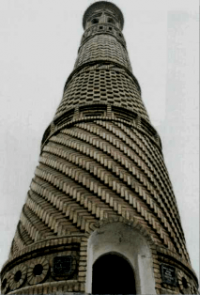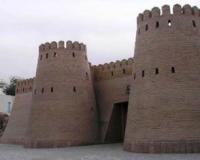You are here
Hazrati-Shoh complex.



Visiting of historical-architectural complex Hazrati-Shoh.
The historical-architectural complex known as is located in the old part of Istravshan town and is composed of 3 religious structures - the Hazratishoh mausoleum, the Khudoyor Va'lami mausoleum and the Hazratishoh mosque (also known as the Namozgoh mosque) arranged in the form of a semicircle around a spring.
Hazratishoh is the name of a saint who was buried here. According to oral legend he was a brother of Kusama Ibn Abbas, who supposedly was buried in the 11th century in Samarqand's Shohi Zinda complex, and who was a cousin of the Prophet Muhammad.
In the past there was a town cemetery, madrassah, qorikhona and nagorkhona next to the mausoleum. According to archives, 12 Qur'an reciters lived in 6 khujrah (cells) in this mausoleum, constantly praying for peace for the souls of the deceased that were buried at the adjoining cemetery of Uroteppa rulers.
In front of the mausoleum there is a spring, the water of which is considered holy and medicinal. According to legend, the spring was formed when Imam Ali put his stick into Mount Oykul Lake (Oydinkul Lake, Turkestan range), and the spring appeared near Hazratishoh's feet at his grave in Uroteppa.
There used to be a market square next to the complex, where, during the Muslim religious holidays of Eidi Qurbon (Eid al-Adha or the "Feast of Sacrifice") and Eidi Ramazon (Eid al-Fitr or the "Feast of Breaking the Fast") a large number of townspeople and residents of neighbouring villages gathered to participate in holiday Namos (public prayer and worship), and from this follows the name of the mosque and a town quarter (guzar) - "Namozgoh".
After prayer, near the mausoleum and mosque, a festival began accompanied by holiday trade, food in teahouses, rooster-, ram-, and quail-fighting, horse-racing, tightrope-walking performances and wrestling.
According to scholars, the history of the Hazra-tishoh religious-memorial complex went as follows. Long before Islam the local population considered the spring to be holy - a source of life. Later, after accepting Islam, the tomb (mazor) of a respected religious figure appeared near the spring.
Afterwards, a simple mausoleum was built over his tomb - a single-chamber over a tomb which later was transformed into two chambers and with an added L-shaped corridor. In the XVII - XVIIIth centuries an ay-von (veranda) with wooden columns was added to the mausoleum.
Mausoleums, burial-vaults and constructions over tombs are a very interesting group of monuments in Central Asia, where the majority of people are Muslims. According to early Islamic views, muslim tombs should not have any construction over them, and even the prophet Muhammad made his will that he be buried in a place without even a tombstone being erected.
However, there has been a large deviation from these religious views. Scholars think that construction of mausoleums is connected with ceremonies and rituals of ancient religions preserved among the local population even after they had accepted Islam, in which they constructed fire temples and various sanctuaries.
In this regard, an interesting find was made in 1940 in a burial crypt near a mazor. Here, several women's tombs were found. One of the corpses had been embalmed. The insides of this corpse had been removed and the abdominal and pelvic cavities filled with a fabric impregnated with antiseptic drugs.
The embalmment was so good that both the mummy and the shroud in which it was covered had not decomposed despite poor conditions for preservation. This mummy shows great scientific interest in the methodology of autopsy, and the means and modes of embalming.
Its discovery says a lot about the level of knowledge in the area of health and chemistry in medieval Central Asia. The constructions in the Hazratishoh complex were each erected at different times and have their own history of creation and use.
As happens frequently, it is very hard to get to the truth now because over the years the building has repeatedly been partially destroyed, rebuilt, completed, and re-designed. Parts of the ancient constructions were disassembled for use as construction materials and firewood.
Also, the premises were used as warehouses for a canning factory during the struggle between Soviet power and "religious remnants". The complex's modem look came mostly from restoration and repair work.
Nowadays the Hazratishoh mausoleum is a double-domed brick construction with a deep alcove on the east side. Khudoyor Va'lami mausoleum is a cross-shaped single crypt. This construction is very simple without any decoration or architectural details or facade.
The cathedral-mosque Namozgoh (Hazratishoh) is a multi-column construction for festive prayers. All the wooden parts of the ceiling, consoles, and capitals are covered with magnificent paintings of green, blue and red colours.
The ayvon ceiling rests upon 28 columns skilfully decorated with woodcarvings. The local population currently actively uses the complex. Trying to determine the exact date of construction has proved difficult.
Some specialists think that the initial buildings were built in the X - XIth centuries - the main arguments for this view are the location of the monument near a spring and some similarity in building design with Samarqand's Shohi Zinda - certain architectural features of the plan, the combination of thick and thin walls, and the presence of galleries surrounding the building on two sides in its planning. Other scholars date this monument with VIIIth century.
Authorship:
Javad Abed Khorasani. http://www.asraresokhan.com







